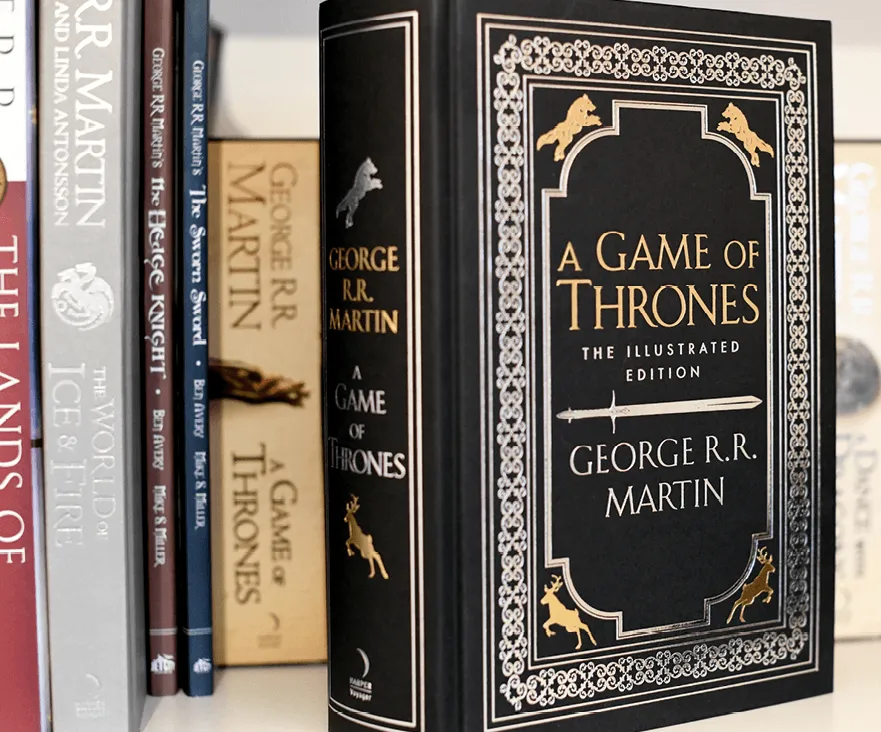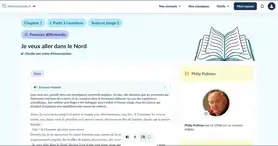Unit 9
Bac
Exam file
Préparation aux évaluations communes
Ressource affichée de l'autre côté.
Faites défiler pour voir la suite.
Faites défiler pour voir la suite.
Évaluations communes
1H30Ressource affichée de l'autre côté.
Faites défiler pour voir la suite.
Faites défiler pour voir la suite.
Compréhension de l'oral The Real Life Characters Behind Game of Thrones
1
Avant l'écoute, Lisez le le titre ci-dessus et regardez le nuage de mots.a. Sur quoi peut porter cet enregistrement ? Faites trois hypothèses.
b. Trouvez cinq autres mots que vous pourriez entendre dans l'enregistrement.
2
Après l'écoute En rendant compte, en français, du document, vous montrerez que vous avez compris les éléments suivants :
- Le thème principal du document ;
- À qui s'adresse le document ;
- Le déroulement des faits, la situation, les événements, les informations ;
- L'identité des personnes ou des personnages et, éventuellement, les liens entre elles / entre eux ;
- Les éventuels différents points de vue ;
- Les éventuels éléments implicites du document ;
- La fonction et la portée du document (relater, informer, convaincre, critiquer, dénoncer, etc.).
Ressource affichée de l'autre côté.
Faites défiler pour voir la suite.
Faites défiler pour voir la suite.


Ressource affichée de l'autre côté.
Faites défiler pour voir la suite.
Faites défiler pour voir la suite.


Ressource affichée de l'autre côté.
Faites défiler pour voir la suite.
Faites défiler pour voir la suite.
The Real Life Characters Behind Game Of Thrones | Behind The Screen, 2017. (Timing: 00:00 to 01:52)
Ressource affichée de l'autre côté.
Faites défiler pour voir la suite.
Faites défiler pour voir la suite.
Compréhension de l'écrit
Was Henry V really a master speechmaker? Did the houses of York and Lancaster really wear emblematic roses? Dan Jones separates fact from fiction in the bard's history plays.
Any historian who sits down to write about the fifteenth century is battling Shakespeare from the moment he lifts his pen. It is a battle he will probably lose.
Shakespeare's portraits of the Plantagenet kings, queens and nobles who ruled and ruined England are so potent that they have, in many cases, become mythically fused with the real, historical men and women themselves.
Who, for example, can think of Henry V without burping up a line or two from the St Crispin's day speech, when ‘we happy few, we band of brothers' gave the dauphin what for? (Henry V 4.3.60). Who is Margaret of Anjou, Henry VI's unfortunate queen, if not the ‘She-wolf of France, but worse than wolves of France, whose tongue more poisons than the adder's tooth'? (3 Henry VI 1.4.551-2).
And when Richard III's skeleton was removed from a Leicester car park last autumn, did not the public excitement basically turn on the chance to discover whether it would resemble that of Shakespeare's hunchbacked spider? Whether we like it or not, Shakespeare's genius informs our imagination of the late Plantagenet kings as surely as Holbein's brush informs our mental picture of the early Tudors. [...]
So it is worth asking exactly what the bard can tell us about the ‘real' history of the fifteenth century. Is there anything that we can usefully take away from the plays? Or are they all just one great enjoyable distortion? Shakespeare wrote in whole or part ten English history plays (eleven if we count Edward III) mostly concentrated in two short creative bursts at the beginning of his career. [...]
The point is that by the end of the sixteenth century, Shakespeare had written an epic cycle of historical plays mostly touching events that took place between 1397 and the triumph of his own Queen Elizabeth's grandfather Henry VII in 1485. In this, he was conventional. From the 1580s there had been a trend for ‘chronicle' plays bringing English royal history to the stage, thanks to the new availability of serious historical works to mine for material.
From his sources, Shakespeare inherited a fair amount of historical bias. Most obviously he picked up the enduring ‘Tudor view' of the Wars of the Roses as a divine punishment somehow earned by the rebellion against natural order that took place when Richard II was deposed. This idea is most keenly felt in Richard II, the three Henry VI plays and, to an extent, Richard III. [...] Few historians today would endorse that view of the Wars of the Roses. There was, for example, no ‘Lancastrian' red rose used during the fifteenth century wars: the red-rose/white-rose dichotomy was largely invented during Henry VII's reign in order to fuse the two emblems in one Tudor rose, which would promote the idea of unity restored through dynasty. [...] Then we must consider that plenty of what Shakespeare wrote was allegorical comment on his own times in the 1590s: an age of dynastic insecurity, foreign menace and noble foment. [...] But even this was not the main point. What we should always remember is that Shakespeare wrote plays primarily to entertain – his plays were never supposed to comprise a history lesson, but simply drew an audience by virtue of its historical setting.
Any historian who sits down to write about the fifteenth century is battling Shakespeare from the moment he lifts his pen. It is a battle he will probably lose.
Shakespeare's portraits of the Plantagenet kings, queens and nobles who ruled and ruined England are so potent that they have, in many cases, become mythically fused with the real, historical men and women themselves.
Who, for example, can think of Henry V without burping up a line or two from the St Crispin's day speech, when ‘we happy few, we band of brothers' gave the dauphin what for? (Henry V 4.3.60). Who is Margaret of Anjou, Henry VI's unfortunate queen, if not the ‘She-wolf of France, but worse than wolves of France, whose tongue more poisons than the adder's tooth'? (3 Henry VI 1.4.551-2).
And when Richard III's skeleton was removed from a Leicester car park last autumn, did not the public excitement basically turn on the chance to discover whether it would resemble that of Shakespeare's hunchbacked spider? Whether we like it or not, Shakespeare's genius informs our imagination of the late Plantagenet kings as surely as Holbein's brush informs our mental picture of the early Tudors. [...]
So it is worth asking exactly what the bard can tell us about the ‘real' history of the fifteenth century. Is there anything that we can usefully take away from the plays? Or are they all just one great enjoyable distortion? Shakespeare wrote in whole or part ten English history plays (eleven if we count Edward III) mostly concentrated in two short creative bursts at the beginning of his career. [...]
The point is that by the end of the sixteenth century, Shakespeare had written an epic cycle of historical plays mostly touching events that took place between 1397 and the triumph of his own Queen Elizabeth's grandfather Henry VII in 1485. In this, he was conventional. From the 1580s there had been a trend for ‘chronicle' plays bringing English royal history to the stage, thanks to the new availability of serious historical works to mine for material.
From his sources, Shakespeare inherited a fair amount of historical bias. Most obviously he picked up the enduring ‘Tudor view' of the Wars of the Roses as a divine punishment somehow earned by the rebellion against natural order that took place when Richard II was deposed. This idea is most keenly felt in Richard II, the three Henry VI plays and, to an extent, Richard III. [...] Few historians today would endorse that view of the Wars of the Roses. There was, for example, no ‘Lancastrian' red rose used during the fifteenth century wars: the red-rose/white-rose dichotomy was largely invented during Henry VII's reign in order to fuse the two emblems in one Tudor rose, which would promote the idea of unity restored through dynasty. [...] Then we must consider that plenty of what Shakespeare wrote was allegorical comment on his own times in the 1590s: an age of dynastic insecurity, foreign menace and noble foment. [...] But even this was not the main point. What we should always remember is that Shakespeare wrote plays primarily to entertain – his plays were never supposed to comprise a history lesson, but simply drew an audience by virtue of its historical setting.
“Shakespeare: did he get his history right?”
Ressource affichée de l'autre côté.
Faites défiler pour voir la suite.
Faites défiler pour voir la suite.
Questions
a) What does the author mean by “battling Shakespeare”?
b) Why does Shakespeare come to mind when these monarchs are mentioned?
c) Did Richard III really exist? How did Shakespeare portray him?
d) Why did Shakespeare choose to write about English Royal history?
e) Read the passage in bold. Explain in your own words what is meant by the ‘Tudor view'.
f) Find two reasons that could explain why Shakespeare distorted historical facts in his plays.
b) Why does Shakespeare come to mind when these monarchs are mentioned?
c) Did Richard III really exist? How did Shakespeare portray him?
d) Why did Shakespeare choose to write about English Royal history?
e) Read the passage in bold. Explain in your own words what is meant by the ‘Tudor view'.
f) Find two reasons that could explain why Shakespeare distorted historical facts in his plays.
Ressource affichée de l'autre côté.
Faites défiler pour voir la suite.
Faites défiler pour voir la suite.
Expression écrite
Choisissez un sujet et répondez-y en anglais en 120 mots minimum.
Sujet A - Texte
Imagine a Shakespearean character based on a famous historical figure you know or like.
Sujet B - Texte - Vidéo
To what extent is history an endless source of inspiration?
Sujet C - Vidéo
Do you think you can learn about history by reading or watching historical fiction? Why or why not?
Ressource affichée de l'autre côté.
Faites défiler pour voir la suite.
Faites défiler pour voir la suite.
- Pensez à rédiger une courte introduction, ainsi qu'une phrase de conclusion.
- Structurez votre travail écrit de manière logique.
- Ne paraphrasez pas les documents.
Une erreur sur la page ? Une idée à proposer ?
Nos manuels sont collaboratifs, n'hésitez pas à nous en faire part.
j'ai une idée !
Oups, une coquille


